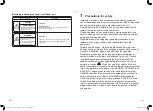
� 17 �
13
Troubleshooting
You can perform fault diagnosis of the outdoor unit with the LEDs on the P.C. Board of the outdoor unit in addition
to using the check codes displayed on the wired remote controller of the indoor unit.
Use the LEDs and check codes for various checks. Details of the check codes displayed on the wired remote
controller of the indoor unit are described in the Installation Manual of the indoor unit.
LED displays and check codes
No.
Error
Display
D800 D801 D802 D803 D804 D805
1
Normal
2
Discharge temperature sensor (TD) error
3
Heat exchanger temperature sensor (TE) error
4
Heat exchanger temperature sensor (TL) error
5
Outside air temperature sensor (TO) error
6
Suction temperature sensor (TS) error
7
Heat sink temperature sensor (TH) error
8
Heat exchanger sensor (TE, TS) connection error
9
EEPROM error
10
Compressor breakdown
11
Compressor lock
12
Current detection circuit error
13
Case thermostat operation
14
Model data not set
15
Discharge temperature error
16
Power supply error
17
High pressure SW error
18
Heat sink overheating error
19
Gas leak detected
20
4-way valve reverse error
21
High pressure release operation
22
Fan system error
23
Drive device short-circuiting
24
Position detection circuit error
25
Compressor IPDU or other (not specifically identified)
: ON, : OFF,
: Rapid flashing (5 times/sec)
* The LEDs and switches are located at the top right
of the P.C. Board of the outdoor unit as shown in the
figure on the table below.
LED displays
D800
(Yellow)
D801
(Yellow)
D802
(Yellow)
D803
(Yellow)
D804
(Yellow)
D805
(Green)
33-EN
34-EN
14
Appendix
[1] Existing piping
Work instructions
The existing R22 and R407C piping can be reused for
our digital inverter R410A product installations.
WARNING
Confirming the existence of scratches or
dents on the existing pipes and confirming the
reliability of the pipe strength are conventionally
referred to the local site.
If the specified conditions can be cleared, it is
possible to update existing R22 and R407C pipes
to those for R410A models.
Basic conditions needed to reuse
existing pipes
Check and observe the presence of three conditions
in the refrigerant piping works.
1.
Dry
(There is no moisture inside of the pipes.)
2.
Clean
(There is no dust inside of the pipes.)
3.
Tight
(There are no refrigerant leaks.)
Restrictions for use of existing pipes
In the following cases, the existing pipes should
not be reused as they are. Clean the existing pipes
or exchange them with new pipes.
1. When a scratch or dent is heavy, be sure to use
new pipes for the refrigerant piping works.
2. When the existing pipe thickness is thinner than the
specified “Pipe diameter and thickness,” be sure to
use new pipes for the refrigerant piping works.
• The operating pressure of R410A is high
(1.6 times that of R22 and R407C). If there is a
scratch or dent on the pipe or a thinner pipe is
used, the pressure strength may be inadequate,
which may cause the pipe to break in the worst
case.
* Pipe diameter and thickness (in (mm))
Pipe outer diameter
1/4” (6.4)
3/8” (9.5) 1/2” (12.7)
Thickness R410A 0.03” (0.8) 0.03” (0.8) 0.03” (0.8)
3. When the outdoor unit was left with the pipes
disconnected, or the gas leaked from the pipes and
the pipes were not repaired and refilled.
• There is the possibility of rain water or air,
including moisture, entering the pipe.
4. When refrigerant cannot be recovered using a
refrigerant recovery unit.
• There is the possibility that a large quantity of
dirty oil or moisture remains inside the pipes.
5. When a commercially available dryer is attached to
the existing pipes.
• There is the possibility that copper green rust has
been generated.
6. When the existing air conditioner is removed after
refrigerant has been recovered.
Check if the oil is judged to be clearly different from
normal oil.
• The refrigerator oil is copper rust green in color:
There is the possibility that moisture has mixed
with the oil and rust has been generated inside
the pipe.
• There is discolored oil, a large quantity of
residue, or a bad smell.
• A large quantity of shiny metal dust or other wear
residue can be seen in the refrigerant oil.
7. When the air conditioner has a history of the
compressor failing and being replaced.
• When discolored oil, a large quantity of residue,
shiny metal dust, or other wear residue or
mixture of foreign matter is observed, trouble will
occur.
8. When temporary installation and removal of the air
conditioner are repeated such as when leased etc.
9. If the type of refrigerator oil of the existing air
conditioner is other than the following oil (Mineral
oil), Suniso, Freol-S, MS (Synthetic oil), alkyl
benzene (HAB, Barrel-freeze), ester series, PVE
only of ether series.
• The winding-insulation of the compressor may
deteriorate.
NOTE
The above descriptions are results have been
confirmed by our company and represent our
views on our air conditioners, but do not guarantee
the use of the existing pipes of air conditioners
that have adopted R410A in other companies.
Curing of pipes
When removing and opening the indoor or outdoor
unit for a long time, cure the pipes as follows:
• Otherwise rust may be generated when moisture or
foreign matter due to condensation enters the pipes.
• The rust cannot be removed by cleaning, and new
pipes are necessary.
Placement
location
Term
Curing manner
Outdoors
1 month or more
Pinching
Less than 1 month
Pinching or taping
Indoors
Every time
1131701101-00_S01_297x210_60p_S_p70_220426.indd 17
26/4/2565 11:41:11




































